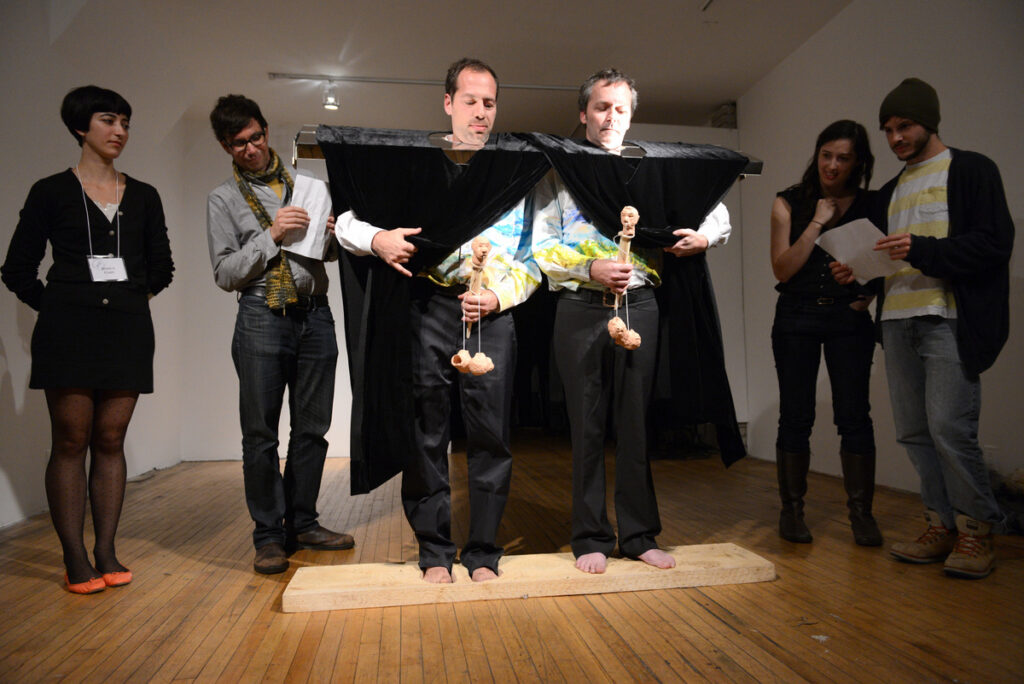By Christine Korte

Carl Bouchard and Martin Dufrasne’s performance on Wednesday night began with us beholding the performers’ heads on a guillotine–like mirrored plank. The two performers were locked into this bizarre contraption, instantly evoking the idea that this could be a troubled union (uh oh!). After completing a perilous round of the gallery space in this contraption, they stood before us and made a big phallic reveal: beneath their velvet-curtained lower-halves they exposed large, hand-held wooden sticks with dangling clay heads (riffing on a frustrating and impossible wooden children’s toy). The duo then began to go about the business of facilitating the evenings’ proceedings, soliciting four bilingual French-English volunteers. They instructed two volunteers to cue their lines of text in French, and another two to translate the lines into English. It was a game of what got “lost in translation” and allowed for a high degree of unpredictability vis-à-vis the volunteer-translators. The onus was on all six persons to be faithful to the text, but the performers’ had relinquished control and had to accomodate different versions of the lines.
The text in question, a dialogue, was uncomfortable at times. It portrayed the intimate dissatisfactions of two people in an undefined relationship. This was a meditation on partnership and easily a political allegory as well. After all, the difficulty of language, translation and co-existence is familiar “territory” in Canada. In any case, the translation issues and the performers’ own failure in their attempts to concurrently play with their hand-held toys (sending little splinters of clay flying), had me on edge. The lines (as they were repeated differently three times) were sometimes funny and at other times absurd (i.e. “you don’t know me” “you don’t want to know yourself”) and hence reminded me – vis-à-vis both the text and the formal elements of the performance – of puppet theatre (Punch & Judy) and even Beckett. These “theatrical” features, however, were undermined by the participatory elements of the performance. Who were we to “listen to”, performer or translator? Furthermore, if we deconstruct the all-is-well “spectacle” of any relationship, what is revealed is a complex web of misunderstandings – the inevitable failure at knowing the “Other”. In spite of this rather bleak upshot, I found the performance moving and poignant – delightful too!
Today’s noon-time “Performance Art Daily” was a continuation of what surfaced in the performance. It was chaired by Jessica Wyman and featured performers Carl and Martin, as well as Camille Turner (who will be facilitating her Sonic Walk on Sunday at 2:30) – all of whom participated in a conversation about “theatricality”. The starting point: what makes performance performance and not theatre? The consensus seemed to be that performance’s concerns center around authenticity, chance, agency (in particular, audience agency), whereas in theatre the audience has a more “fixed” position, just as the artist has a more fixed intention. But what is performance trying to do “to” or “with” the audience?
The individual practitioners responded to these questions, as did audience members. Camille Turner shared her experiences bringing her Miss Canadiana project into the all Black community of North Preston, Nova Scotia. When she told community members that Miss Canadiana was a performance, a fictional intervention, rather than feeling “duped” one person exclaimed “so we can do this too?”. I think that all of us present were inspired by this anecdote. Camille also discussed the extent to which her practice responds to the contingencies of location and audience reactions as they surface, “tapping into the situation as a vehicle for possibilities”.
The discussion migrated to a broader conversation around an “ethics” of performance interventions, particularly where the audience may not be aware a “performance” is happening. In this kind of situation, however, authentic responses allow both facilitator and participant to be opened, surprised (transformed even?) by the encounter in a way that isn’t possible in a gallery space where the audience is often more deferential. And finally, one individual raised the all-important issue of documenting performance without consent – both within the gallery space, as well as outside of it. Suffice it to say that all of the concerns raised in today’s talk reinforce the necessity of conversation between performance artists specifically, as well as the reality that festivals remain a rare opportunity for these conversations to take place.
I didn’t make it to yoga this morning, but the word was that it was a work out! I did, however, arrive for the latter half of VERB WOMAN ART AKTION and got to participate in some collective magic-making with fabric, and to witness the spontaneous dance-poetry of my festival peers. Tomorrow’s VERB WOMAN promises to be highly politicized. Apparently, we are being mobilized into AKTION in the spirit of solidarity!
